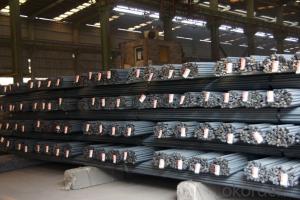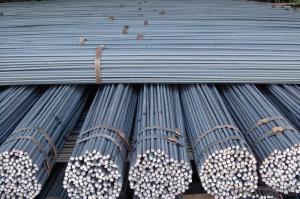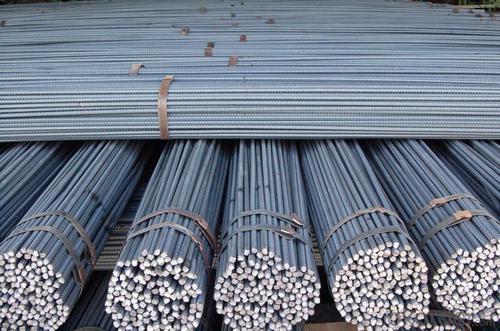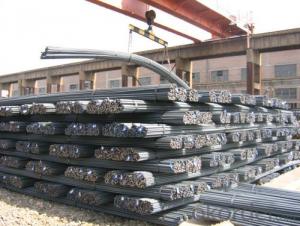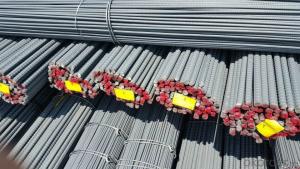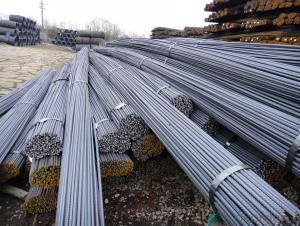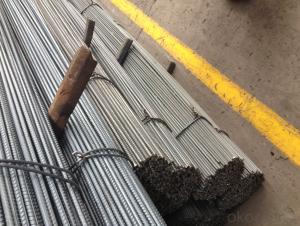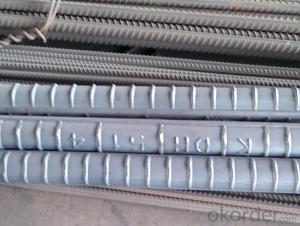Good quality deformed bars with grade HRB400
- Loading Port:
- Tianjin
- Payment Terms:
- TT OR LC
- Min Order Qty:
- 25 m.t.
- Supply Capability:
- 100000 m.t./month
OKorder Service Pledge
OKorder Financial Service
You Might Also Like
Product Description:
Specifications of HRB400 Deformed Steel Bar:
Standard | GB | HRB400 | |
Diameter | 10mm-32mm | ||
Length | 6M, 12M | ||
Place of origin | Hebei, China mainland | ||
Advantages | exact size, regular package, chemical and mechanical properties are stable. | ||
Type | Hot rolled deformed steel bar | ||
Chemical Composition: (Please kindly find our chemistry of our material based on HRB400 as below for your information)
Grade | Technical data of the original chemical composition (%) | ||||||
C | Mn | Si | S | P | V | ||
HRB400 | ≤0.25 | ≤1.60 | ≤0.80 | ≤0.045 | ≤0.045 | 0.04-0.12 | |
Physical capability | |||||||
Yield Strength (N/cm²) | Tensile Strength (N/cm²) | Elongation (%) | |||||
≥400 | ≥570 | ≥14 | |||||
Theoretical weight and section area of each diameter as below for your information:
Diameter(mm) | Section area (mm²) | Mass(kg/m) | Weight of 12m bar(kg) |
18 | 254.5 | 2.00 | 24 |
20 | 314.2 | 2.47 | 29.64 |
22 | 380.1 | 2.98 | 35.76 |
Usage and Applications of HRB400 Deformed Steel Bar:
Deformed bar is widely used in buildings, bridges, roads and other engineering construction. Big to highways, railways, bridges, culverts, tunnels, public facilities such as flood control, dam, small to housing construction, beam, column, wall and the foundation of the plate, deformed bar is an integral structure material. With the development of world economy and the vigorous development of infrastructure construction, real estate, the demand for deformed bar will be larger and larger..
Packaging & Delivery of HRB400 Deformed Steel Bar:
Packaging Detail: products are packed in bundle and then shipped by container or bulk vessel, deformed bar is usually naked strapping delivery, when storing, please pay attention to moisture proof. The performance of rust will produce adverse effect.
Each bundle weight: 2-3MT, or as required
Payment term: TT or L/C
Delivery Detail: within 45 days after received advanced payment or LC.
Label: to be specified by customer, generally, each bundle has 1-2 labels
Trade terms: FOB, CFR, CIF

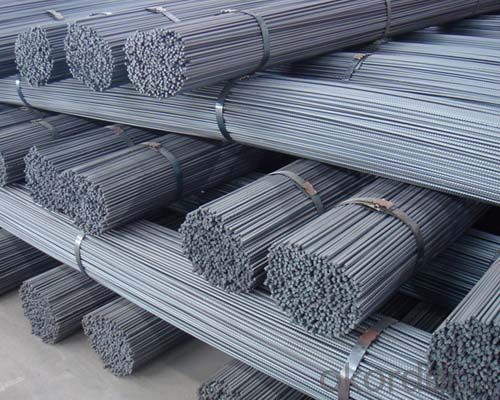
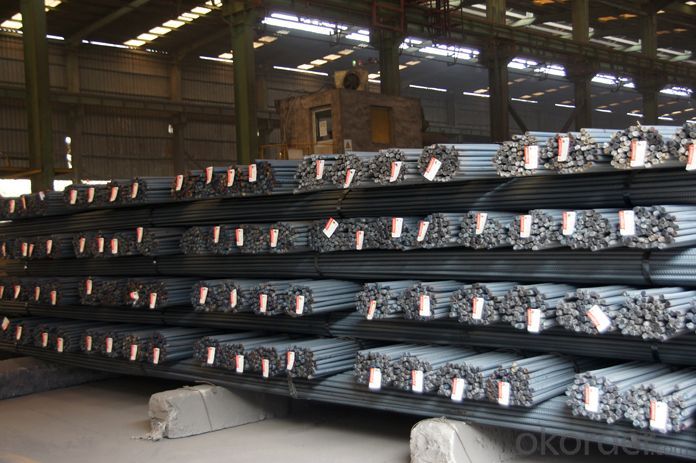
*If you would like to get our price, please inform us the size, standard/material and quantity. Thank you very much for your attention.
- Q: How are steel rebars used in the construction of airports?
- To ensure the overall strength and stability of various concrete structures in airport construction, steel rebars are extensively utilized. These rebars, also known as reinforcing bars, are typically made of steel and are strategically placed within concrete elements like beams, columns, slabs, and foundations. In the context of airport construction, rebars primarily serve to reinforce the concrete used in runways, taxiways, and aprons. Runways, subjected to heavy loads and constant aircraft movements, require significant reinforcement to withstand immense pressure and prevent cracking or structural failure. By embedding steel rebars within the concrete, its tensile strength is enhanced, enabling it to bear heavy loads without compromising the runway's integrity. Similarly, taxiways and aprons, which accommodate aircraft taxiing, parking, and refueling, also rely on steel rebars for reinforcement. These areas experience continuous vehicle and equipment traffic, making them susceptible to wear and tear. By incorporating rebars in the concrete, these surfaces can endure constant stress and weight, ensuring durability and longevity. Apart from runways, taxiways, and aprons, steel rebars are also utilized in constructing other airport structures such as terminal buildings, control towers, hangars, and parking facilities. These structures necessitate strong foundations and sturdy frames to support the building's weight and withstand environmental factors like wind and seismic forces. Steel rebars are employed to reinforce the concrete foundations, columns, and beams, providing the necessary strength and stability. Overall, steel rebars play a vital role in airport construction by enhancing the structural integrity and durability of various concrete elements. They ensure airport facilities can endure heavy loads, constant traffic, and adverse weather conditions associated with air travel, guaranteeing the safety and efficiency of airport operations.
- Q: What are the different types of steel rebars used in bridge construction?
- There are several types of steel rebars commonly used in bridge construction, including carbon steel rebars, epoxy-coated rebars, stainless steel rebars, and galvanized rebars. Each type has specific properties and advantages, such as corrosion resistance, durability, or increased strength, which make them suitable for different bridge construction scenarios.
- Q: What is the typical weight per meter of a steel rebar?
- The typical weight per meter of a steel rebar can vary depending on its size and grade. However, as a general guideline, a standard mild steel rebar with a diameter of 10 millimeters (mm) usually weighs around 0.616 kilograms per meter (kg/m). For larger sizes, such as a 20 mm rebar, the weight per meter can increase to approximately 2.47 kg/m. It is important to note that these values are approximate and may vary slightly depending on the specific manufacturing standards and regional regulations.
- Q: Are steel rebars suitable for use in industrial facilities?
- Yes, steel rebars are highly suitable for use in industrial facilities. Steel rebars are commonly used in construction projects to reinforce concrete structures, and their robustness and strength make them ideal for industrial facilities where heavy loads and high-stress environments are common. The use of steel rebars helps enhance the structural integrity and load-bearing capacity of the facility, ensuring it can withstand the demands of industrial operations. Additionally, steel rebars are highly resistant to corrosion, which is a crucial factor in industrial settings where exposure to moisture, chemicals, and other corrosive substances is prevalent. Overall, steel rebars provide the necessary strength, durability, and corrosion resistance required for industrial facilities, making them a suitable choice for reinforcing concrete structures in such environments.
- Q: How do steel rebars impact the overall aesthetics of concrete structures?
- Steel rebars have a significant impact on the overall aesthetics of concrete structures. While concrete is known for its strength and durability, it lacks the tensile strength to resist bending or stretching forces. This is where steel rebars come into play. By reinforcing concrete with steel rebars, the structural integrity of the concrete is greatly enhanced. This allows engineers and architects to design more complex and ambitious structures, such as high-rise buildings, bridges, and stadiums. The use of steel rebars provides the necessary strength and flexibility to withstand heavy loads, seismic activity, and other environmental forces. However, the presence of steel rebars can affect the appearance of the concrete structure. In some cases, particularly in exposed concrete finishes, the visibility of steel rebars can be seen as a visual distraction or an undesirable element. The exposed steel rebars may create a grid-like pattern or a rusty appearance, which can be perceived as unattractive or out of harmony with the surrounding environment. To mitigate this aesthetic impact, various techniques are employed. One common approach is to use concrete coverings or coatings to hide the steel rebars and create a smooth and uniform surface. These coverings not only serve the purpose of improving the appearance but also provide protection against corrosion and extend the lifespan of the structure. Another method is to employ decorative techniques such as formwork or molds to create unique patterns or textures on the concrete surface. This way, the steel rebars are concealed within the design, adding to the overall aesthetic appeal of the structure. By incorporating architectural features, such as curves or geometric shapes, the presence of steel rebars can be turned into a visual asset rather than a hindrance. It is worth noting that in certain architectural styles, such as Brutalism, the raw and exposed nature of concrete structures, including the visibility of steel rebars, is celebrated as an artistic expression. In these cases, the industrial and utilitarian aesthetic is embraced, and the steel rebars become an integral part of the overall design concept. In conclusion, steel rebars have a significant impact on the aesthetics of concrete structures. While their presence can sometimes be seen as an obstacle to achieving a desired visual outcome, various techniques and design approaches can be employed to either conceal or incorporate steel rebars into the overall architectural design, resulting in aesthetically pleasing and structurally sound concrete structures.
- Q: What is the lifespan of steel rebars in concrete structures?
- The lifespan of steel rebars in concrete structures can vary due to a range of factors. Generally, steel rebars are designed to provide concrete structures with durability and strength. Through proper design, construction, and maintenance, steel rebars can endure for many decades or even up to a century within concrete structures. One crucial factor that affects the lifespan of steel rebars is the quality of materials utilized. Rebars of high quality, which have corrosion-resistant coatings or are made of stainless steel, tend to last longer compared to regular carbon steel rebars. Moreover, the quality of the concrete used and its ability to shield the rebars from moisture and corrosive agents is also significant. Environmental conditions play a significant role in determining the lifespan of steel rebars. Exposure to harsh climates, such as regions with high humidity, saltwater, or acidic environments, can expedite corrosion and reduce the lifespan of the rebars. Adequate protective measures, such as maintaining the proper thickness of concrete cover, implementing waterproofing techniques, and utilizing corrosion inhibitors, can help extend the lifespan of steel rebars in such conditions. Maintenance and inspection are essential to ensure the longevity of steel rebars in concrete structures. Regular inspections should be conducted to detect signs of corrosion, cracking, or damage, and any necessary repairs or protective measures should be promptly undertaken. In certain cases, periodic coating or replacement of rebars may be necessary to uphold the structural integrity of the concrete elements. In conclusion, the lifespan of steel rebars in concrete structures can range from several decades to over a century, depending on various factors including material quality, environmental conditions, and proper maintenance. By implementing appropriate design, construction, and maintenance practices, the lifespan of steel rebars can be significantly prolonged, guaranteeing the long-term integrity and durability of the concrete structure.
- Q: Can steel rebars be used in dam construction?
- Yes, steel rebars can be used in dam construction. Steel rebars are commonly used in the construction of dams to reinforce concrete structures and provide added strength and durability. They help to withstand the immense pressure and weight of water, making them an essential component for dam stability and longevity.
- Q: What is the difference between drawing steel and round steel on drawing?
- When drawing steel, it should be used to correct the name: ribbed steel bar, whose name is abbreviated as "HRB" in English. At the same time, according to the characteristic value of yield strength, it can be divided into three grades: HRB335, HRB400 and HRB500, and should be marked when marked.Bar diameter and material should be marked on the drawing, such as material of 35 / Cr12.
- Q: Can steel rebars be used in power plant construction?
- Yes, steel rebars can be used in power plant construction. Steel rebars are commonly used as reinforcement in concrete structures, including power plants, to enhance their strength and durability.
- Q: How do steel rebars improve the structural integrity of concrete?
- Steel rebars improve the structural integrity of concrete in several ways. First and foremost, they enhance the tensile strength of concrete, which is otherwise weak in tension. Concrete has excellent compressive strength but lacks the ability to withstand pulling or stretching forces. By inserting steel rebars into the concrete, the tensile strength of the entire structure is significantly increased. The steel rebars act as reinforcement by distributing the stress and load across a wider area, preventing cracks and fractures from propagating through the concrete. They provide a strong bond between the concrete and the reinforcement, allowing the structure to bear heavy loads and resist bending, shearing, and other forces that can compromise its stability. Additionally, steel rebars help to control and mitigate the effects of shrinkage and thermal expansion and contraction that occur in concrete. These phenomena can often lead to cracking and structural damage. The steel rebars help to restrain the movement of the concrete, reducing the risk of cracks forming and ensuring the overall integrity of the structure. Furthermore, steel rebars increase the durability and longevity of concrete structures. They have high resistance to corrosion, which is especially important in environments with high moisture, chemicals, or saltwater exposure. The presence of steel rebars protects the concrete from deterioration and extends the lifespan of the structure. In summary, steel rebars play a crucial role in improving the structural integrity of concrete by enhancing its tensile strength, distributing stress and loads, preventing cracks, controlling shrinkage, resisting bending and shearing forces, and increasing durability. They provide a reliable and effective reinforcement system that ensures the stability and longevity of concrete structures.
Send your message to us
Good quality deformed bars with grade HRB400
- Loading Port:
- Tianjin
- Payment Terms:
- TT OR LC
- Min Order Qty:
- 25 m.t.
- Supply Capability:
- 100000 m.t./month
OKorder Service Pledge
OKorder Financial Service
Similar products
Hot products
Hot Searches
Related keywords
